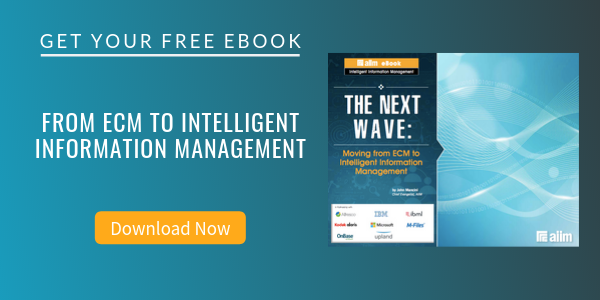/Garden-Lifecycle-Header-1280-600.png)
How to Manage Information - Growing Your Own Success
Intelligent Information Management (IIM)
Here at AIIM, we believe that information is a business asset. Your information has the potential to help you digitally transform and understand, anticipate, and redefine experiences for your customers.
But, information is a different type of asset. An asset like money is much more straight-forward because it’s easy to see its value and easy to understand. Your information is much different in that it needs attention in order to become an asset.
Imagine for a moment if you just had a bunch of cash hiding all over your office that you didn’t know about. The moment you opened a drawer and discovered a pile of money, you’d be excited right away – not a single drawer in your office would be left unopened. However, how likely is it that cash is just hiding all over your office? And if it is, can I come to visit?!
Information, on the other hand, IS hiding all over your business. But, nobody is getting as excited about “opening a drawer” and finding a pile of it. In fact, many just close that drawer and act like it never happened.
This is the case for many of us; our information is just sort of there, unmanaged, invisible, and stored in a bunch of different places.
Intelligent Information Management (IIM) is the tools, strategy, and planning used to fully-leverage your information. IIM makes it so your information has value, has use, and IS something to get excited about.
By this point, you might be asking, “What the heck does that IIM thing really mean? It sounds complicated.”
So, let’s simplify and dig deeper.
Growing Success with Intelligent Information Management
One of my favorite ways to teach (and learn) is through the use of analogies. Comparing something simple, routine, and well-understood helps connect the dots for the learner and can make complex things easier to understand.
So today, we’re going to explore IIM through the lens of gardening! Your information is like plants you might find in a garden. Some plants are nutritious, and are tasty in a salad; others are noxious and can choke out the good ones. Some are nice to look at, but quickly proliferate to obscure those tasty fruits and vegetables until they rot. Information management is like gardening - bringing the skills, processes, and tools to bear to keep the garden (and your information!) healthy and productive.
Ready to dig in and get our hands dirty? Let’s start here. This link brings up an interactive infographic. I recommend keeping this up in a new tab or window to refer back to as we go along. Also, feel free to take a minute to click around and explore the infographic. There are lots of call-outs with key terms, definitions, and even five additional pages you can access for tons of free resources, solution providers, best practices, and more.
Creating, Capturing, and Sharing Information (Planting the Seed)
We have to start somewhere. In our gardens, we usually start by planting the seeds of what we want to grow. You can grab a pack of “information seeds” here on Amazon. I’m kidding, of course. But as noted earlier, information already exists all over your business. It’s coming and going all the time. So, a better way to think of it is designing your garden.
In this first step, it’s about identifying where information is being created in your business, what information is being created, and how this information could be utilized and leveraged elsewhere within the business.
From the infographic:
“Collectively, creating and capturing information form the first step in the intelligent information management lifecycle. Indeed, it sets the stage for everything that follows. Organizations implement information management systems in support of creating, capturing, and sharing information and ensuring its usefulness to the organization.”
Explore free resources, solution providers, case studies and more from this domain.
Digitalizing Information-Intensive Processes (Watering)
A seed won’t grow without water. Water is needed to help the plant grow and eventually produce fruit. What does our information need to grow and produce “fruit”? It needs to turn digital.
Digital information is scalable, sharable (between systems), and can be automated. The idea behind this step is to make your information garden something that continues to scale with you.
From the infographic:
“IIM calls for a fundamental rethinking of how we approach key business outcomes. It requires that information be digitized and that work processes be developed or reworked, with a focus on digital-first and automation wherever possible. And it requires that organizations adopt a posture of agility and responsiveness rather than one of passivity and reactivity.”
Explore free resources, solution providers, case studies and more from this domain.
Automating Governance and Compliance (Protecting the Garden)
Our information doesn’t just have value to us. Just the same as you’re not the only one dreaming about the tomatoes in your garden (isn’t that right, Mr. Woodchuck?) – hackers and cyber threats also see value in your business information.
For the garden, we prepare fences and keep an eye out to protect it. We set up precautions in advance to make sure our garden is safe to grow.
As farmers, we’re the ones concerned with the fences and pesticides. The person who finally eats the apple that we grew doesn’t even have to think about all the hard work that went into protecting that apple. They can just enjoy the apple.
With governance and compliance, information professionals are the farmers. We’re the ones who set in place the automated governance and compliance to protect our information. And therefore, our knowledge workers just get to “enjoy the apple.”
Our gardens and information also require pruning and weeding. Untended growth, like weeds, can choke off access to the important things and even result in good plants being torn up with the bad if the weeding isn't careful. IM is doing the gardening: the arrangement, the weeding out of extraneous, the pruning of things that need to be in order to support the overall health of the garden. Weeds in our information come in the form of something called Information ROT (redundant, obsolete, and trivial). ROT can unnecessarily increase storage costs, cause confusion, and clog up search.
From the infographic:
“To be effective, organizations have to embrace the approach of “streamline and automate.” Governance and compliance tasks need to be made as simple as possible (but no simpler). And they need to be automated to the maximum extent possible – to the point where users have no idea that things like information security and records management are even happening.”
Explore free resources, solution providers, case studies and more from this domain.
Extracting Intelligence from Information (Harvesting)
At this point, we’ve come to the end of our growing season, and we’re ready to harvest. Our garden is full of mature plants with plenty of fruit to pick.
In IIM, this is where we utilize and leverage our information. By now, we’re capturing/creating the information, we have it in a digital format, we’ve protected it, and in this step, we’re putting it to use.
From the infographic:
“This is the gateway for leveraging and exploiting information in support of the organization’s goals and objectives. Information needs context, and we need to provide that context in a way that doesn’t burden users but instead supports them.
The tools and processes that serve business needs and outcomes can offer significant benefit in terms of understanding information in new ways and in being able to leverage that intelligence to drive innovation and the customer experience.”
Explore free resources, solution providers, case studies and more from this domain.
Implementing an Information Management Strategy (Replant and Rebuild)
What’s next after harvesting the garden? Getting ready to do it all again next season – but better!
You can do the same with your information management. Every year, grow the strategy, get better, and do more.
From the infographic:
“Digital transformation is about doing things differently – and doing different things as well. And different not just for the sake of being different, but in support of the key strategic objectives facing every organization in the age of digital disruption. In other words, digital transformation is not about incremental process improvement. Digital transformation is about using information in brand new ways.
Organizations need to focus on how to effectively monetize their information assets, directly or indirectly, to move the organization forward. Information management must become a business enabler. Implementing the right information management strategy will allow this to progress.”
Explore free resources, solution providers, case studies and more from this domain.
Conclusion
Anyone who has ever started a garden knows that it’s not an overnight thing. It takes time, patience, and effort. Think of your IIM journey in the same way.
Personally, we started our small veggie garden just a couple of years ago. The first year, it’s a surprise we even grew anything because of the number of mistakes we made. But, we stuck with it, researched like crazy, and made it a point to improve year after year. This year, we had our best harvest yet!
So, as you begin to embark on your Intelligent Information Management journey, think of AIIM as your local gardening club. We have tons of free resources, training, certification, and more. We’re here to help you grow!








